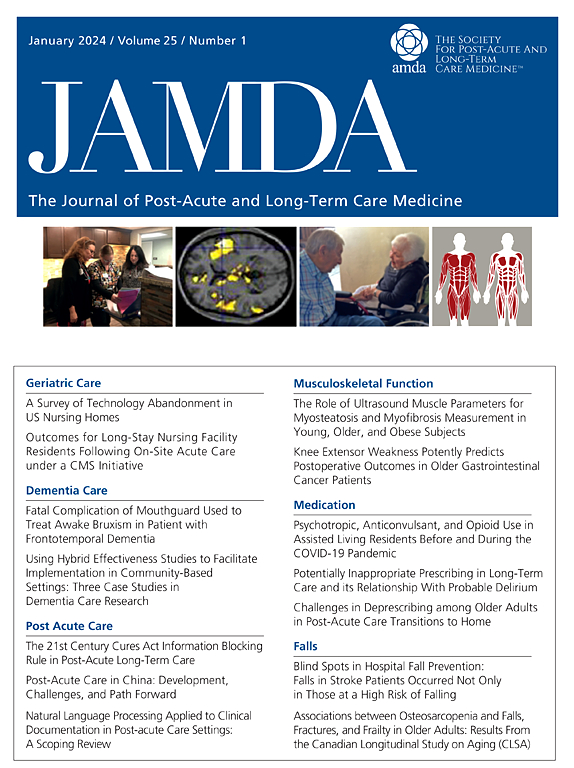长期照护机构住客临终关怀之亲属参与:欧盟5国之横断面研究。
IF 4.2
2区 医学
Q2 GERIATRICS & GERONTOLOGY
Journal of the American Medical Directors Association
Pub Date : 2025-02-24
DOI:10.1016/j.jamda.2025.105492
引用次数: 0
摘要
目的:确定长期照护机构(ltcf)居民临终前一周亲属参与临终照护的程度和相关因素。设计:横断面回顾性调查。环境和参与者:在比利时、芬兰、意大利、荷兰和波兰的229个LTCF的代表性样本中,共有814名已故LTCF居民的亲属。方法:ltcf报告了过去3个月内所有居民的死亡情况。在每种情况下,标准化问卷被发送给LTCF经理、护士、医生和参与护理最多的亲属。采用多变量逻辑回归模型来评估亲属和已故居民的哪些因素和特征与在生命的最后一周与居民共度的时间有关。结果:与波兰相比,来自荷兰的亲属(优势比[OR], 14.22;95% CI, 6.56-30.82),比利时(OR, 10.24;95% CI 4.87-24.52),芬兰(OR, 2.57;95% CI, 1.18-5.58)在生命的最后一周与居民共度超过14小时的几率更高。女性亲属,是他们的伴侣或配偶,并且在住院者入住LTCF之前每周提供超过11小时的照顾(or, 2.96;(95% CI 1.55-5.65)更有可能在生命的最后一周访问垂死的居民。由于行为问题或日常生活活动依赖而被安置在LTCF的居民在生命的最后一周被亲属探望的频率较低(or, 0.34;95% CI为0.16-0.71,OR为0.54;95% CI分别为0.36-0.82)。结论和意义:住院患者在进入LTCF时的行为问题和依赖与他们的亲属在临终关怀中的参与度较低有关。我们还发现,不同国家的亲属参与程度存在巨大差异。需要进一步的研究来确定这些差异的原因,并为亲属提供特定文化的支持。本文章由计算机程序翻译,如有差异,请以英文原文为准。
Engagement of Relatives in End-of-life Care of Residents in Long-Term Care Facilities: A Cross-Sectional Study in 5 EU Countries
Objective
To determine the extent and factors associated with relatives' engagement in end-of-life care for residents of long-term care facilities (LTCFs) during the last week before the resident's death.
Design
A cross-sectional retrospective survey.
Setting and Participants
A total of 814 relatives of deceased LTCF residents in a representative sample of 229 LTCFs in Belgium, Finland, Italy, the Netherlands, and Poland.
Methods
LTCFs reported all residents’ deaths in the past 3 months. In each case, standardized questionnaires were sent to the LTCF manager, nurse, physician, and relative most involved in care. A multivariable logistic regression model was applied to assess which factors and characteristics of the relative and deceased resident were associated with more time spent with the resident in the last week of life.
Results
Compared with Poland, relatives from the Netherlands [odds ratio (OR), 14.22; 95% CI, 6.56–30.82], Belgium (OR, 10.24; 95% CI 4.87–24.52), and Finland (OR, 2.57; 95% CI, 1.18–5.58) had higher odds of spending more than 14 hours with residents in the last week of life. Female relatives, who were their partners or spouses, and who provided more than 11 hours of care weekly before the resident's admission to the LTCF (OR, 2.96; 95% CI 1.55–5.65) were more likely to visit the dying resident during the last week of life. Residents placed in the LTCF due to their behavioral problems or dependency in activities of daily living (ADL) were less frequently visited by their relatives in the last week of life (OR, 0.34; 95% CI, 0.16–0.71 and OR, 0.54; 95% CI, 0.36–0.82, respectively).
Conclusions and Implications
Resident's behavioral problems and dependency in ADLs at the time of admission to the LTCF were associated with their relative's lower engagement in end-of-life care. We also found substantial differences in relatives' engagement among countries. Further research is required to identify the causes of these discrepancies and to develop culture-specific support for relatives.
求助全文
通过发布文献求助,成功后即可免费获取论文全文。
去求助
来源期刊
CiteScore
11.10
自引率
6.60%
发文量
472
审稿时长
44 days
期刊介绍:
JAMDA, the official journal of AMDA - The Society for Post-Acute and Long-Term Care Medicine, is a leading peer-reviewed publication that offers practical information and research geared towards healthcare professionals in the post-acute and long-term care fields. It is also a valuable resource for policy-makers, organizational leaders, educators, and advocates.
The journal provides essential information for various healthcare professionals such as medical directors, attending physicians, nurses, consultant pharmacists, geriatric psychiatrists, nurse practitioners, physician assistants, physical and occupational therapists, social workers, and others involved in providing, overseeing, and promoting quality

 求助内容:
求助内容: 应助结果提醒方式:
应助结果提醒方式:


